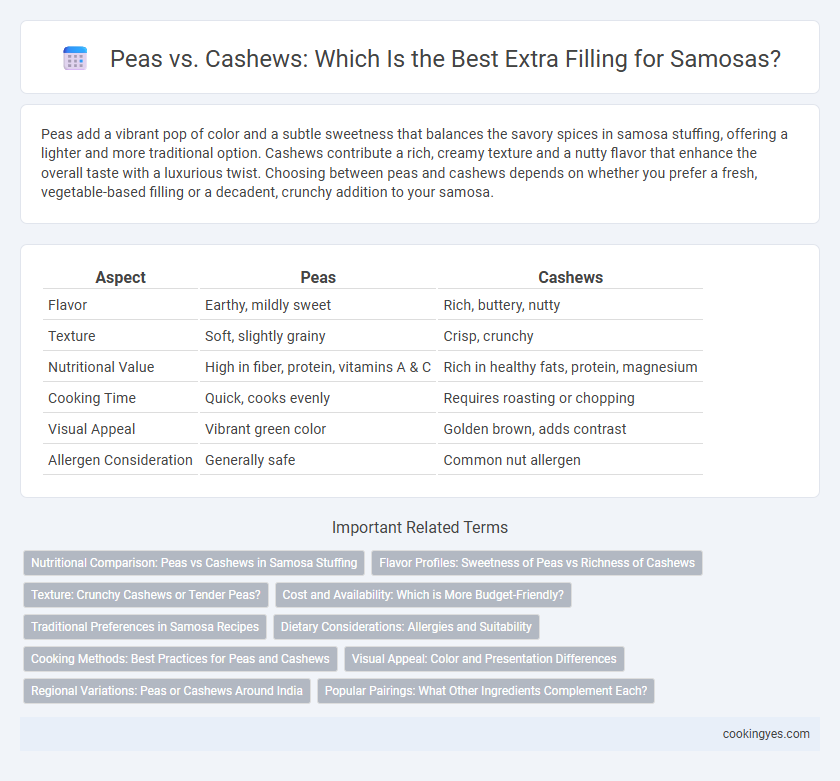Peas add a vibrant pop of color and a subtle sweetness that balances the savory spices in samosa stuffing, offering a lighter and more traditional option. Cashews contribute a rich, creamy texture and a nutty flavor that enhance the overall taste with a luxurious twist. Choosing between peas and cashews depends on whether you prefer a fresh, vegetable-based filling or a decadent, crunchy addition to your samosa.
Table of Comparison
| Aspect | Peas | Cashews |
|---|---|---|
| Flavor | Earthy, mildly sweet | Rich, buttery, nutty |
| Texture | Soft, slightly grainy | Crisp, crunchy |
| Nutritional Value | High in fiber, protein, vitamins A & C | Rich in healthy fats, protein, magnesium |
| Cooking Time | Quick, cooks evenly | Requires roasting or chopping |
| Visual Appeal | Vibrant green color | Golden brown, adds contrast |
| Allergen Consideration | Generally safe | Common nut allergen |
Nutritional Comparison: Peas vs Cashews in Samosa Stuffing
Peas in samosa stuffing provide a rich source of dietary fiber, protein, and essential vitamins like vitamin C and folate, supporting digestion and immune health. Cashews contribute healthy monounsaturated fats, higher calorie content, and minerals such as magnesium and copper, enhancing energy and antioxidant intake. Choosing peas or cashews for samosa stuffing depends on whether the focus is on lower calorie nutrition and fiber or on richer fats and minerals for sustained energy.
Flavor Profiles: Sweetness of Peas vs Richness of Cashews
Peas in samosa stuffing introduce a subtle sweetness and earthy freshness that balances the spices while maintaining a light texture. Cashews contribute a rich, buttery flavor and a creamy crunch, enhancing indulgence and adding depth to the filling. Opting for peas emphasizes a vibrant, garden-inspired taste, whereas cashews elevate richness and create a more decadent samosa experience.
Texture: Crunchy Cashews or Tender Peas?
Samosas stuffed with crunchy cashews offer a rich, nutty texture that contrasts delightfully with the flaky pastry, providing a satisfying bite. Tender peas deliver a softer, slightly creamy texture that blends seamlessly with spices, enhancing the filling's moisture and flavor balance. Choosing between crispy cashews or tender peas ultimately shapes the overall mouthfeel and texture experience of the samosa.
Cost and Availability: Which is More Budget-Friendly?
Peas are generally more budget-friendly and widely available throughout the year, making them an economical choice for samosa stuffing. Cashews, being a premium ingredient, tend to be costlier and less accessible in large quantities, increasing the overall preparation expense. For cost-conscious cooking, peas offer a practical and affordable stuffing option without compromising on flavor.
Traditional Preferences in Samosa Recipes
Traditional samosa recipes predominantly favor peas as the primary additional stuffing ingredient, lending a subtle sweetness and soft texture that complements the spicy potato filling. Cashews are less commonly used but add a rich, crunchy contrast and a nutty flavor, often reserved for festive or regional variations. Culinary preferences vary by region, with peas symbolizing authenticity in North Indian samosas and cashews enhancing richness in certain Mughlai-inspired recipes.
Dietary Considerations: Allergies and Suitability
Peas offer a hypoallergenic alternative for samosa stuffing, suitable for individuals with nut allergies and providing a rich source of plant-based protein and fiber. Cashews, while adding a creamy texture and healthy fats, pose a risk for those with tree nut allergies and may not be suitable for all dietary restrictions. Choosing peas over cashews ensures broader dietary compatibility, especially for allergen-sensitive consumers seeking nutritious and safe snack options.
Cooking Methods: Best Practices for Peas and Cashews
Steaming peas before adding them to samosa filling preserves their vibrant color and natural sweetness, while sauteing cashews in ghee enhances their crunchiness and imparts a rich, nutty flavor. Incorporating cooked peas maintains moisture balance and prevents the stuffing from becoming dry, whereas lightly roasting cashews prevents them from turning bitter and ensures even texture. Optimal cooking methods emphasize gentle heat and minimal oil to retain the distinct taste and nutritional benefits of both peas and cashews in samosa stuffing.
Visual Appeal: Color and Presentation Differences
Peas add vibrant green hues to samosas, enhancing visual appeal with a fresh, lively burst of color that contrasts well against the golden-brown crust. Cashews contribute a warm, creamy beige tone, creating a richer, more luxurious presentation but with less color contrast than peas. The choice between peas and cashews significantly affects the samosa's color palette, influencing its attractiveness and perceived flavor profile.
Regional Variations: Peas or Cashews Around India
In Indian regional variations of samosa stuffing, peas dominate in northern and western states like Punjab and Gujarat, where the vegetable filling is favored for its subtle sweetness and texture. Conversely, cashews are popular in parts of southern India and Maharashtra, adding a rich, crunchy contrast that complements spiced potato mixtures. These regional preferences highlight the cultural diversity in Indian snacks, with peas symbolizing traditional, everyday fare and cashews representing festive, luxurious versions.
Popular Pairings: What Other Ingredients Complement Each?
Peas enhance samosas with a subtle sweetness and soft texture, pairing well with spices like cumin, coriander, and garam masala to create a classic, comforting filling. Cashews add a rich, creamy crunch that complements earthy ingredients such as potatoes, onions, and mild chilies, elevating the samosa's flavor profile with a luxurious touch. Combining peas and cashews in the stuffing results in a balanced contrast of smooth and crunchy textures, making the samosa both flavorful and satisfying.
Peas vs Cashews for additional stuffing Infographic

 cookingyes.com
cookingyes.com